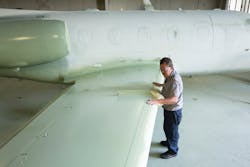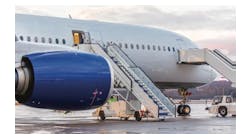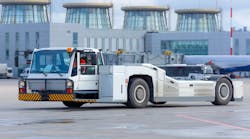Now home to the Beechcraft and Cessna businesses, one look at the new Textron Aviation logo clearly shows the iconic brands of Beechcraft, Cessna, and Hawker remain distinct, with a combined portfolio of complementary general aviation products and services.
Brad Thress, senior vice president, Customer Service, says, “Textron Aviation stands fully committed to service capabilities supporting Beechcraft, Cessna, and Hawker owners. Our combined global service network continues to provide uninterrupted service and support for all Hawker aircraft. With 21 worldwide company-owned service facilities, the Textron Aviation global service network remains available for service, maintenance and technical support for all Hawker and Beechcraft, as well as Citation, aircraft.”
Wichita Mid-Continent Airport now sports two Textron Aviation service facilities – one located on the airport’s east side and one located on the airport’s west side. Between the two Textron Aviation Service Centers customers spanning the Beechcraft, Cessna and Hawker brands can bring their aircraft to Wichita for maintenance, inspections, parts, repairs, avionic upgrades, equipment installations, refurbishments, and other specialized services.
The Hawker 400XPR
This small cabin jet has a long history which began decades ago. In 1986 Beechcraft bought the rights to produce the aircraft and it was re-designated as the Beechjet 400. Brian Howell, vice president, Parts, Programs and Business Development with Textron Aviation, explains in mid-2012 the Hawker 400XPR program was launched which incorporated several performance enhancements such as aerodynamic winglets and the Williams International FJ44-4A 32 engine, along with the latest in flight deck avionics, custom interiors and exteriors, and a cabin management system, all available as an a’la carte menu for customers to customize from.
Howell says, “These upgrades take the aircraft from a 1,333 nautical mile aircraft to a 1,950 nautical mile aircraft with four passengers and will climb direct to FL490 in only 19 minutes. This can be done by combining the new engine capability of the Williams FJ44-4A with the Genuine Hawker winglets. The upgrade will also decrease the overall operating costs of the aircraft as well as increase resale value. We have also included a significant amount of options the customer could choose as “add-ons” to the upgrade. Both Rockwell Collins Pro Line 21 and Garmin 5000 avionics will be offered, as well as customized interior, new paint, and warranty options that can all be added to the base XPR package.”
Regarding maintenance Howell says, “The upgrade doesn’t change the overall Chapter 5 maintenance schedule, but it will however increase the TBO from 3,600 hours on the current JT15-D to 5,000 hours on the FJ44. As the OEM of the aircraft, we have also designed a few STCs around some of the most frustrating maintenance aspects of the aircraft (bleed air and nose strut access) to also add in some reliability improvements that should complement the overall upgrade as well.”
One new Hawker owner is NASCAR favorite Martin Truex Jr. The Truex Hawker recently underwent an XPR upgrade program at Textron Aviation in Wichita which, when completed, will include the winglet modification, installation of the Williams International engines, an interior refurbishment, other maintenance enhancements, and of course new exterior paint.
Painting the Truex Hawker
Many critical activities go into an aircraft upgrade, one of those being application of new exterior paint. Currently the Textron Aviation Service Centers in Wichita operate two paint booths with a new state-of-the-art paint booth scheduled to be operational soon. The new paint booth will have a modified cross-draft airflow with full strip and paint capabilities allowing for better control of the paint environment by accurately controlling temperature and air flow, and help eliminate more contaminates such as dust that older style paint booths could not.
Rob Tanner, paint manager, says, “The booth will be a new tool for our painters and will help make the quality of paint jobs better the first time limiting clean up and detail work. We will also start using state-of-the-art electrostatic paint guns which help with overspray allowing for better paint transfer, a more consistent coat on uneven surfaces, and eliminating waste.”
Tanner explains how understanding what truly is a great paint job is the first step in producing a great paint job. He says, “Quality does not happen by accident. Following and controlling the quality of each step of the process ensures a great paint job is done correctly. This means after each step whether it is the existing paint removal process or surface preparation for paint, the aircraft is inspected and areas of concern are identified and corrected before the next step. When the aircraft is delivered it has to not only meet regulatory requirements, but also the quality requirements of the customer. It’s key the customer will like the paint job for the life of the paint job. The only way to do that is to not only deliver a product that is appealing, but one that will also last with the proper care.”
Tanner explains the quality of a paint job is not determined by the booth, but by the detail of work done by the painters. He says of the painters, “We currently have two job types in the paint shop; those who prepare the aircraft and those who paint the aircraft. Both do prep and detail work and the painters apply the base coats and stripes. The people we hire already have paint experience whether it is aircraft or automotive. After we choose a candidate for a job position they are trained on the job with close monitoring.”
Before the aircraft is even touched, the first step of the process is working with the customer to come up with a paint scheme. The paint scheme is first designed using a computer program, resulting with a digital rendering. The rendering shows the stripe design as well as the colors used, which correspond with Sherwin William paint color charts and fan decks. Sometimes “spray outs” are sent to customers so they get a true visual representation of the colors that will be used.
The paint process begins with removing flight controls, masking areas of the aircraft that would be affected by chemical paint stripper, and a final inspection to ensure all masking has been done correctly. The clock begins ticking when the chemical stripper is applied. Depending on how the aircraft was previously painted, it can take a couple applications of chemical paint stripper, followed by a water rinse and more paint removal on areas not affected or missed by the stripper. Preparing the aircraft for alodine can take a couple days in order to again inspect the entire aircraft surface to ensure the smoothest of surfaces. After the alodine has been applied and removed the aircraft is ready for primer.
Sherwin-Williams Aerospace Coatings products were used on the Truex aircraft. The first step in paint application was the Corrosion Preventative Primer and when dry the aircraft is again inspected for any small imperfections of the primer application. Next was the Sanding Surfacer followed by a final sanding to ensure complete smoothness for good adhesion of the base paint. Jet Glo Express was used for the white basecoat requiring careful application to ensure uniform application. Once dry the basecoat was inspected for any imperfections and corrected as needed.
Now for the really creative part: the striping! Textron Aviation commented using one of two ways to lay out stripes. The first method is to make a mask made from a previous design. The second method requires the keen eye of a talented person who can look at a rendering and then lay out the design directly on the aircraft. This method requires the design be laid out on one side of the aircraft and then a pattern is made for use on the other side. Once the stripes are laid out the entire aircraft must be masked again and the areas that get color are sanded, cleaned, sprayed, and the process continues. Textron Aviation used a combination of both methods for this aircraft. The colors used on the stripes were High Solid Gloss Acry Glo Black, Toreador Red, and Charcoal Gray.
In preparation for customer delivery, flight controls are detailed, balanced, and reinstalled, placards are installed, sealant is applied as needed, and the aircraft completely inspected (again) to ensure the highest quality is achieved. During acceptance, the customer works with the paint team to review and inspect the entire aircraft to ensure the customer flies away happy with a new shiny aircraft.
Rob Tanner concludes by saying, “In the rare occasion a problem with the paint occurs, Textron Aviation stands by the product with a three-year warranty on metal aircraft and one year on composite.”



